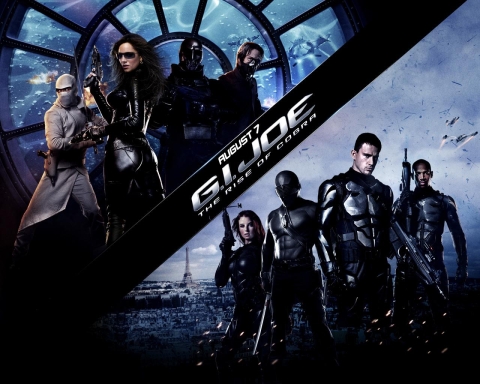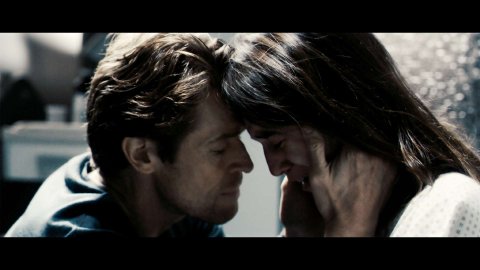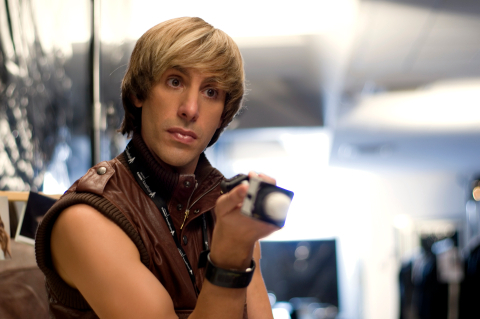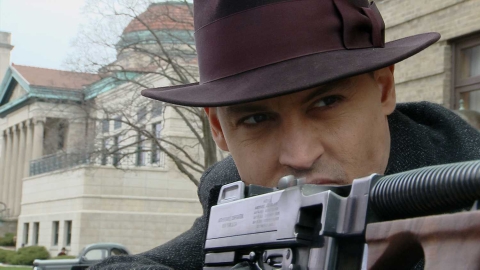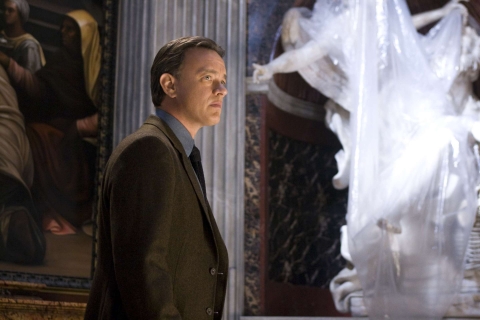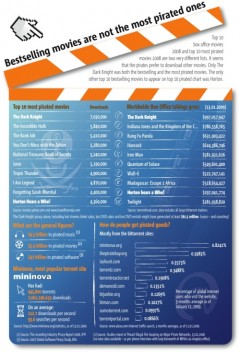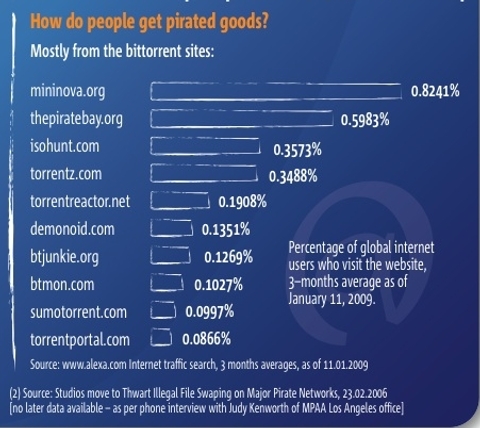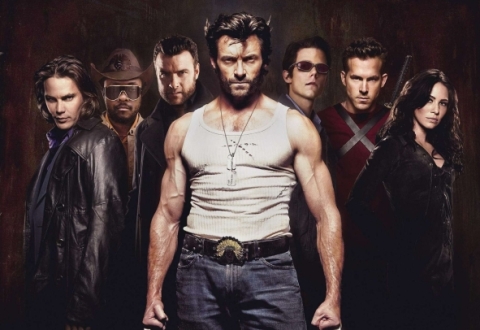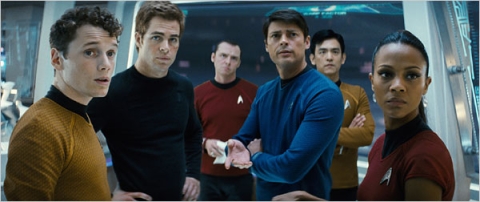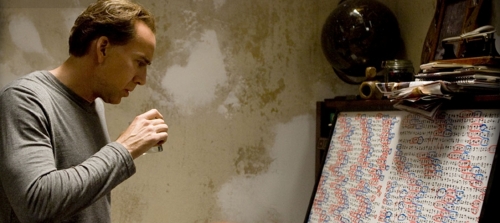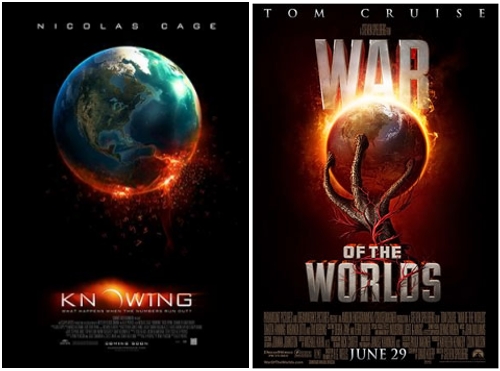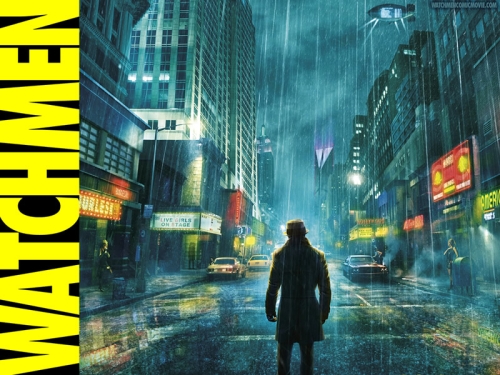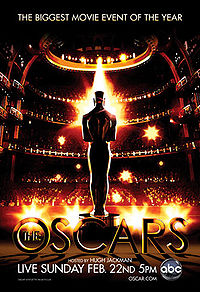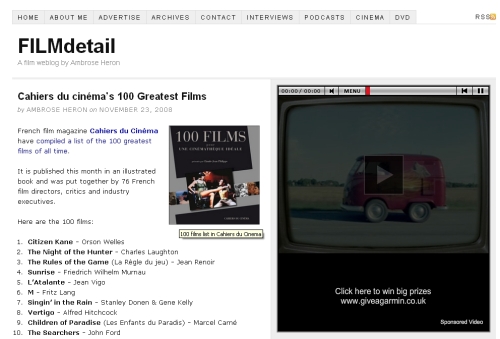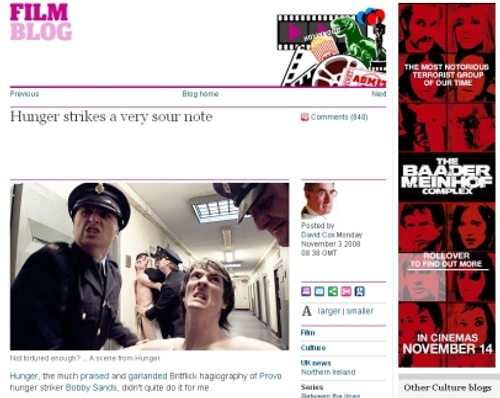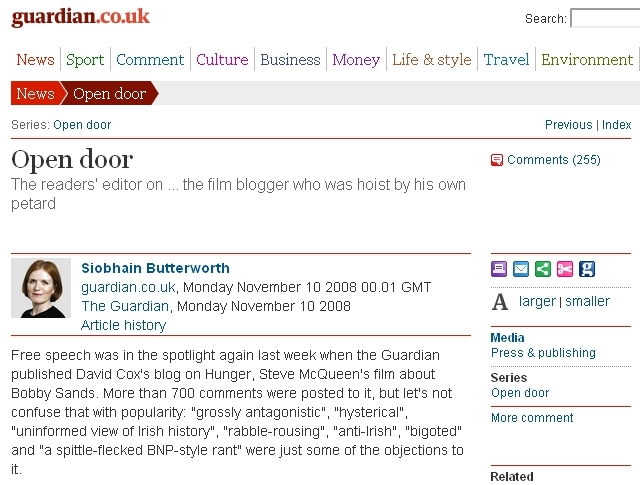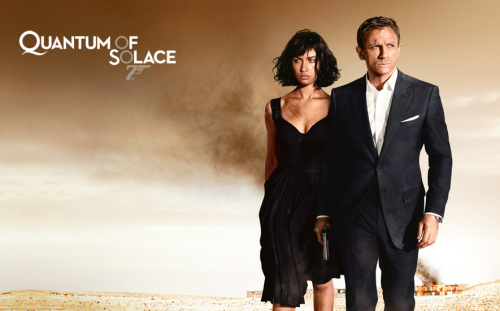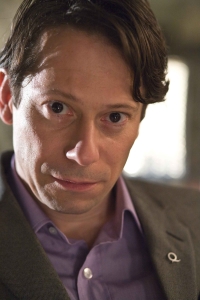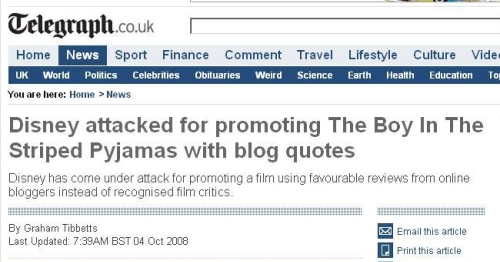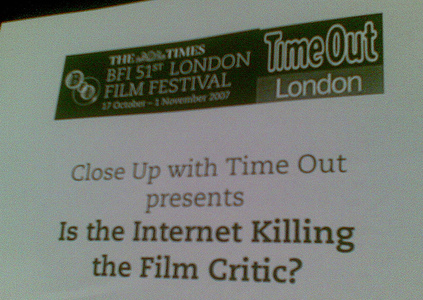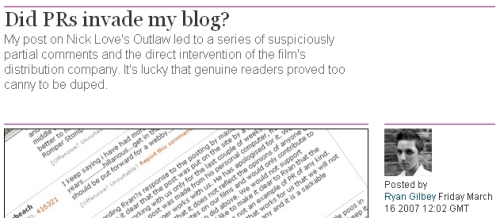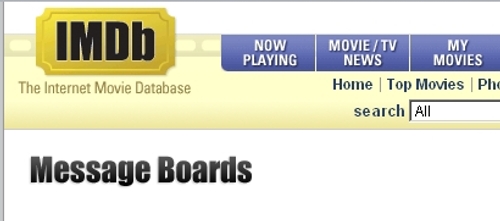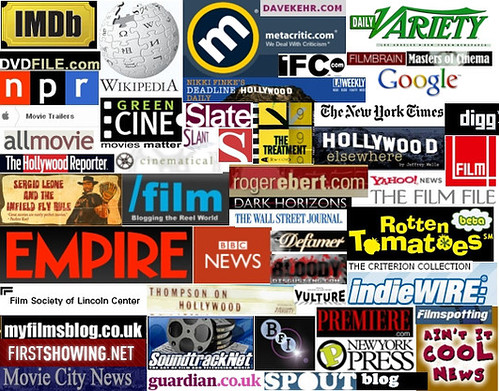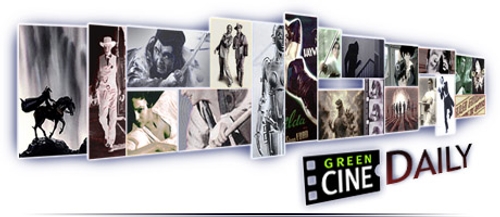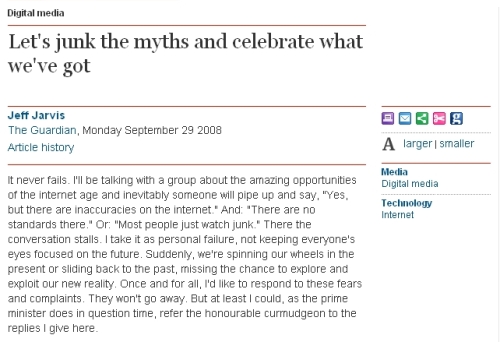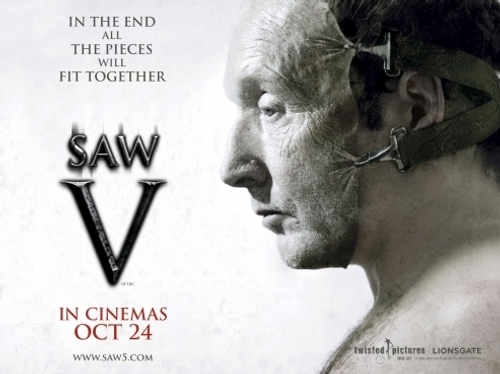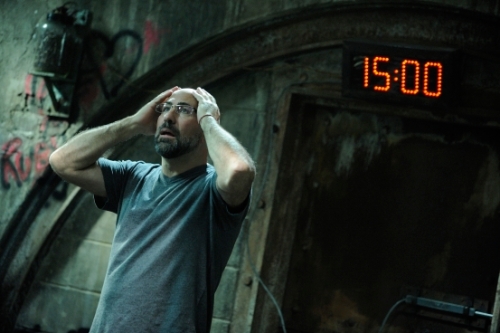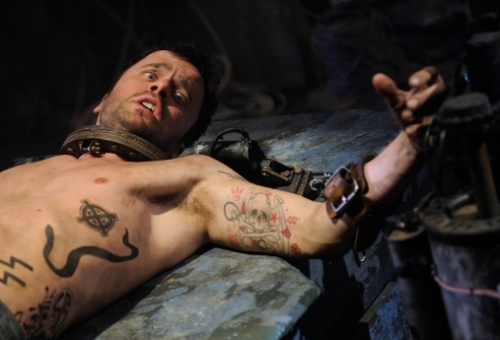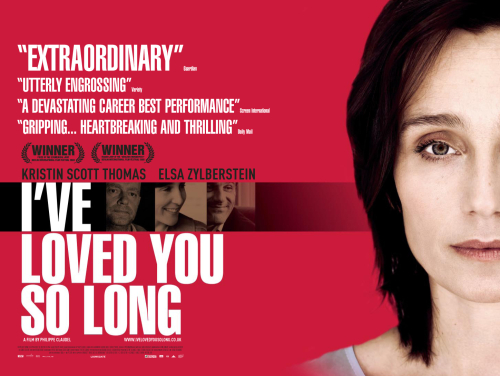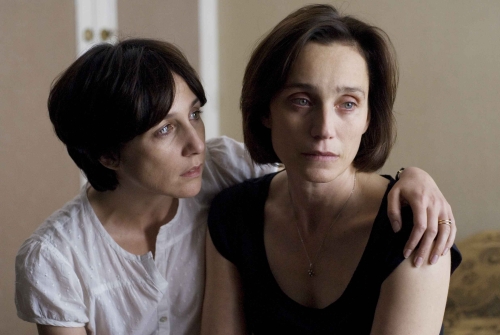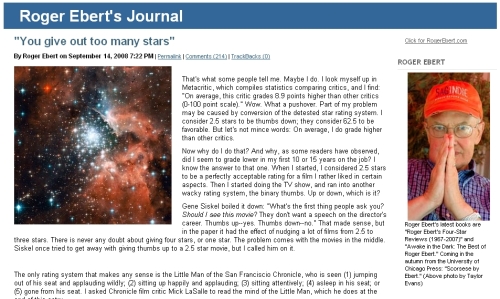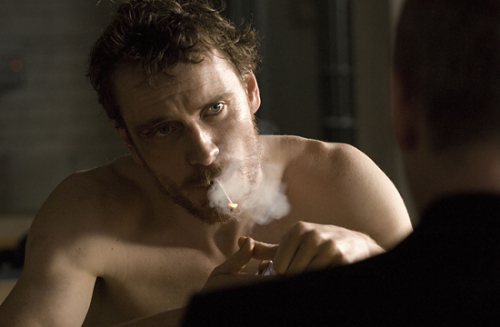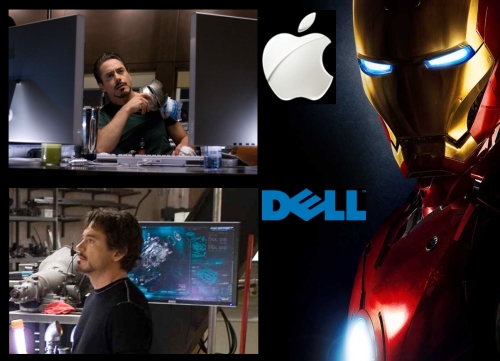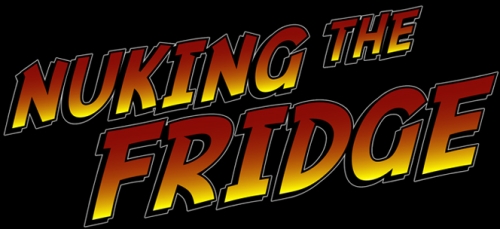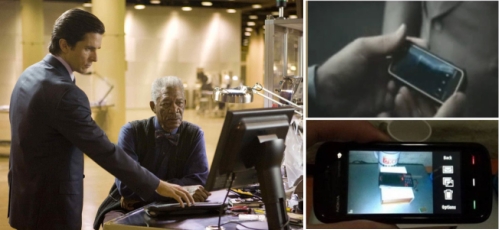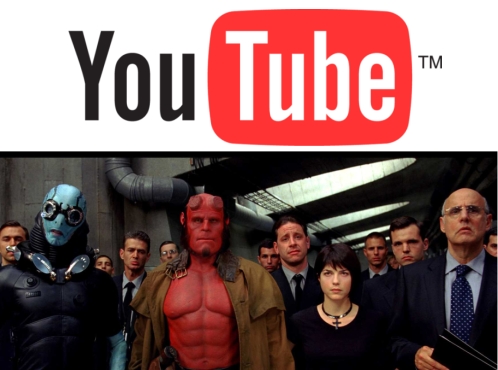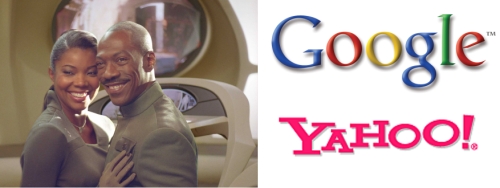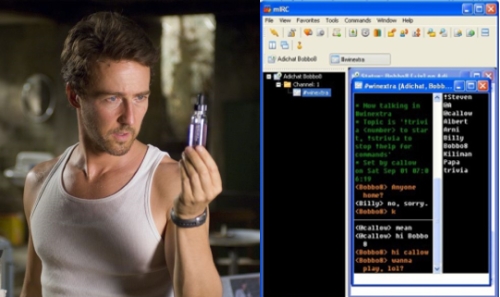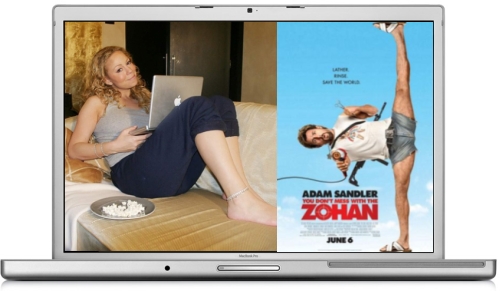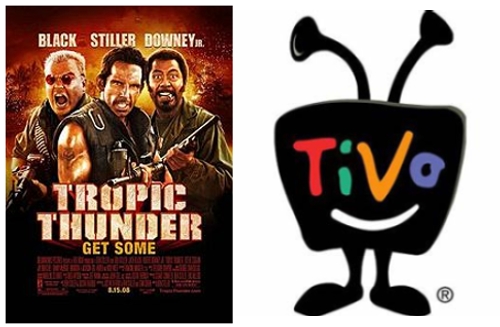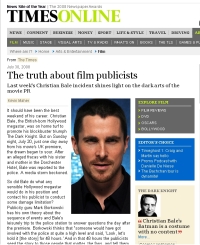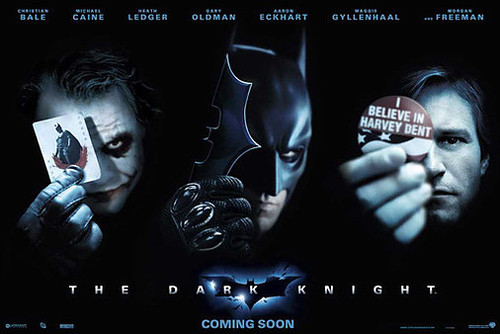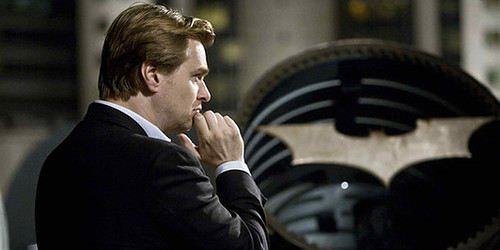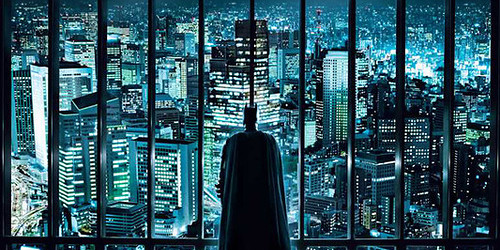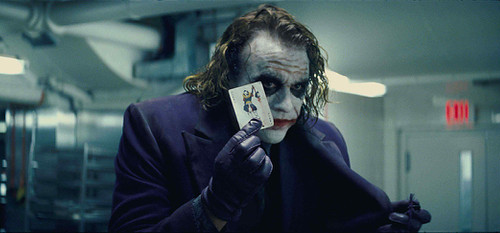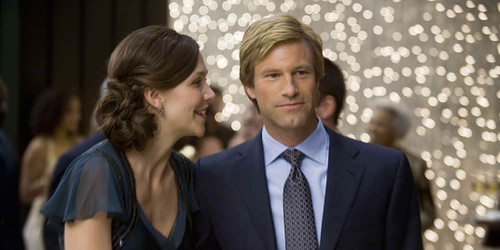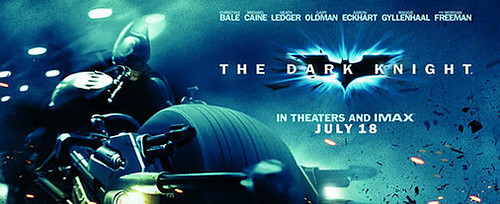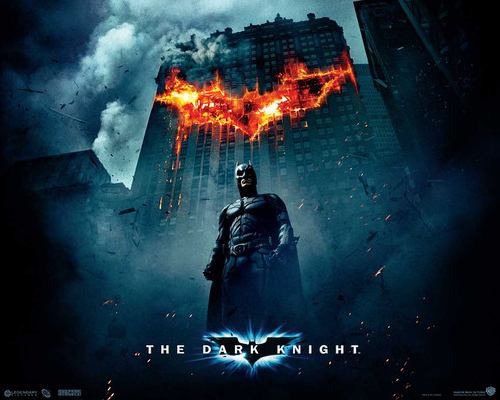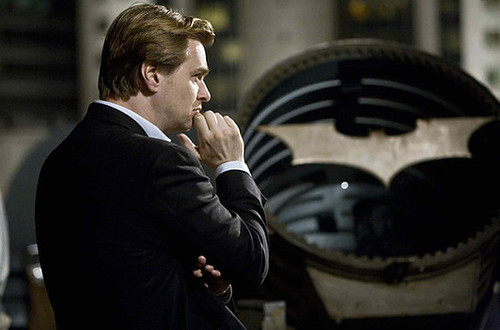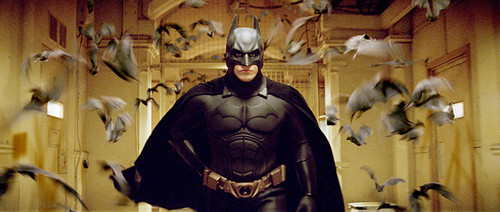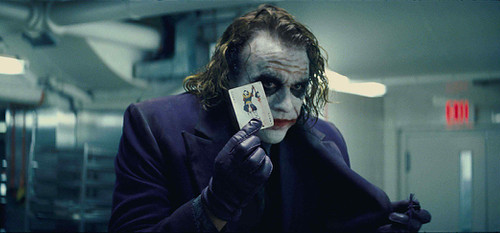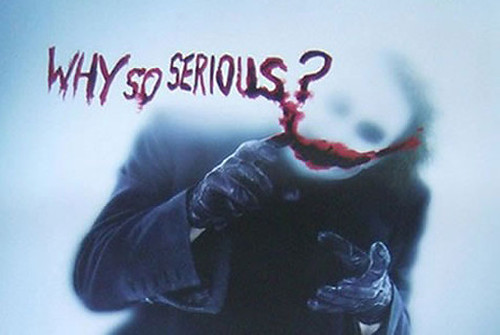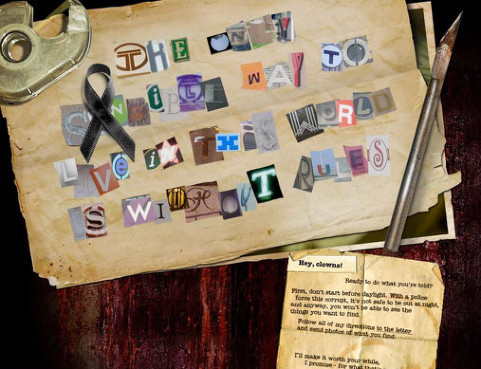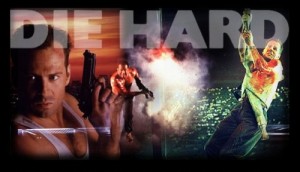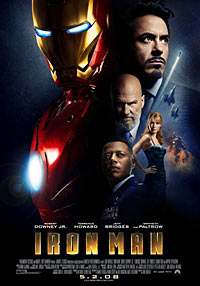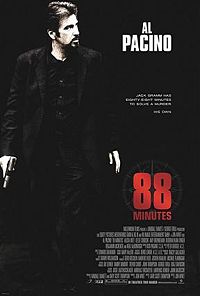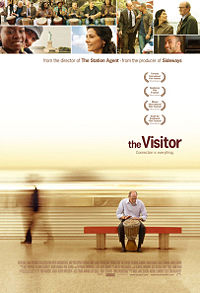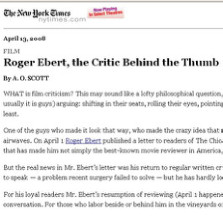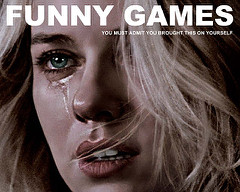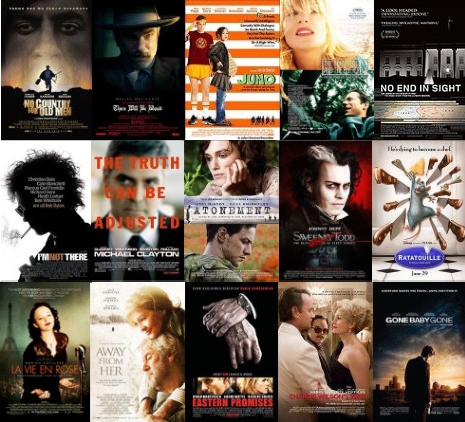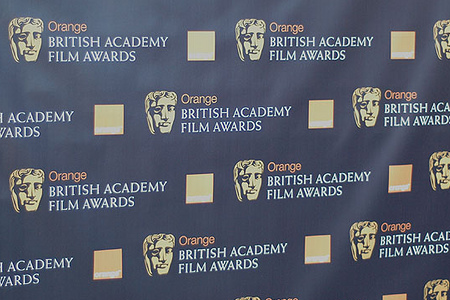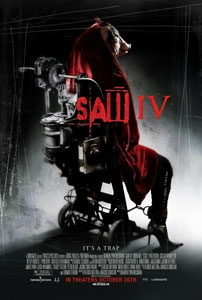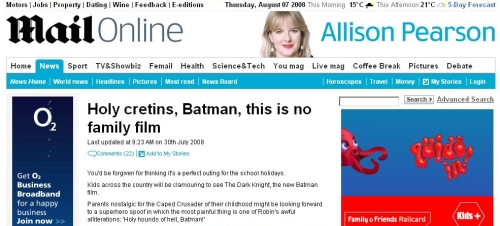
Last week in The Daily Mail columnist Alison Pearson helped kick off a silly bout of hysteria with a column about The Dark Knight.
She wrote:
Nothing in this new Batman is in jest. Not even the Joker. This film is doing serious business – and, make no mistake, its business is violence.
I saw The Dark Knight on Monday; or at least I saw the bits that I could bear to watch from behind my giant Diet Coke.
Fair enough. If you find the film hard to watch, then that is entirely how you experienced it.
It is dark, oppressive and filmed in a realistic style, especially for a comic book movie. Plus points as far as I’m concerned, and maybe that’s also true for the record-breaking audiences and large selection of critics who also loved it.
However, the picture she painted was not exactly accurate.
Let’s examine the bits she found so repellent:
Within the first five minutes, the body count was in double figures – and that was before a detonator was shoved down the throat of a dying bank manager.
Yes, that’s true but she neglects to mention that it doesn’t actually go off, which is handy if you want to portray the opening sequence as some kind of exploding head filled monstrosity.
But not good if you want to be precise about what actually happens on-screen.
She goes on:
Soon afterwards, the Joker, played with diabolical brilliance by the late Heath Ledger, explained how he got that permanent blood-red clown’s grin.
His father had been attacking his mother’s face with a knife when he caught his young son watching with a serious expression.
Dad slashed the boy’s cheeks to make sure that the kid would never look down-in-the-mouth again.
As far as I could see and hear this wasn’t on-screen violence – it was a character talking.
Plus, if you pay attention you will notice that throughout the film the Joker gives different stories about how he got the scars, suggesting he is lying or screwing with people’s heads. Creepy? Yes. Violent? No.

Then she brings up the scene in which the Joker kills a gangster with a pencil:
Consider this. If Batman had climbed out of bed and walked across the room to find his rubber boxers, thus showing his Batbum, the film would have been rated a 15 – nudity being deemed far more shocking than cutting people’s throats, obviously.
Personally, I would be far happier for my children to glimpse Batman’s buttocks than to see a pencil skewered into a man’s eye, but what do I know?
Whilst I agree that sex is seen by censors as more taboo than violence (especially in the US) the problem with her point is that at no point do we see a pencil going in to an eye.
In fact, we don’t see any contact between face and pencil. Not only does it happen so quickly, but the camera cuts away so that even if you slowed it down I don’t think you would even see any actual gore in the frame.
The violence is implied, not shown. It certainly gives the audience a jolt but it is nothing like the grisly scene being painted here.
All of this might sound like standard Fleet Street outrage but the really troubling bit comes when a connection is made to the recent death of a teenager in London:
The day I went to see the film, I happened to drive past the spot where 16-year-old Ben Kinsella was stabbed 11 times. He was the 21st teenager to die of knife wounds in London this year.
His killers may have thought they were some kind of cartoon masters of the universe, meting out a perverse justice, but the scruffy street corner with its altar of rotting bouquets tells a different story.
No stirring music bestowed a thrilling poetic grandeur on Ben’s last seconds. No giant shadow of a cape flitted across the sky. Nobody could save him. Especially not this Batman.
What exactly is the point here? That the Joker’s taste for knives will lead to more deaths? The new Batman (a fictional character let’s remember) can’t save vulnerable children?
 What on earth is she actually saying with this ill-advised detour into a much more serious issue?
What on earth is she actually saying with this ill-advised detour into a much more serious issue?
That seemed to be the end of that, but it now appears that a snowball of indignation from a Daily Mail columnist is threatening to become an avalanche of idiocy.
Now, a cluster of clueless MPs and right wing commentators have all recently turned their sights on the film and the BBFC for awarding it a 12A certificate.
They seem to be rather upset that the film didn’t get than a 15 certificate.
For those unfamiliar with the film ratings system in the UK, each film is given one the following ratings before it can be shown in UK cinemas or sold/rented as a DVD:
-
Uc (Universal Children): Suitable for all, but especially suitable for young children to watch on their own (home media only)
-
U (Universal): Suitable for all, but parents are advised that certain scenes may be unsuitable for children under 4 years old.
-
PG (Parental Guidance): All ages admitted, but parents are advised that certain scenes may be unsuitable for children under 8
-
12A (12 Accompanied/Advisory): Suitable for those aged 12 and over. Those aged under 12 are only admitted if accompanied by an adult at all times during the performance (replaced the standard 12 certificate for cinema releases only in 2002)
-
12: Suitable for those aged 12 and over. No-one younger than 12 may rent or buy a 12 rated VHS, DVD or game (home media only since 2002)
-
15: Suitable for those aged 15 and over. Nobody younger than 15 may see a 15 film in a cinema. No-one younger than 15 may rent or buy a 15 rated VHS, DVD or game.
-
18: Suitable for those aged 18 and over. Nobody younger than 18 may see an 18 film in a cinema. No-one younger than 18 may rent or buy an 18 rated VHS, DVD or game.
-
R18 (Restricted 18): Suitable for those aged 18 and over. May only be shown at licensed cinemas or sold at sex shops, and only to people aged 18 or over.
 The body that awards these certificates is called the BBFC (British Board of Film Classification), which is the organisation responsible for viewing films (and some video games) and given them one of the ratings above.
The body that awards these certificates is called the BBFC (British Board of Film Classification), which is the organisation responsible for viewing films (and some video games) and given them one of the ratings above.
The Dark Knight was given a 12A which is, let us not forget, a restrictive certificate in that only those under 12 can see it if they are accompanied by an adult.
But clearly this isn’t good enough for the loons who want to see The Dark Knight reclassified as a 15.
Here some samples of what is being said.
The Daily Mail said yesterday in an another article (this time by Olinka Koster and Caroline Grant) that:
The violent new Batman movie has been given a 15 and 16 certificate by many countries – heaping fresh pressure on beleaguered film censors.
Parents say they have been ‘let down’ by the British Board of Film Classification which maintains that a ‘family friendly’ 12A rating is the right classification for The Dark Knight.
Parents? OK, some have complained.
But what sample size are we talking about here? And to what extent did the paper go chasing people who they knew didn’t like the film?
Are they really telling us they couldn’t find anyone who wasn’t outraged by the violence? But why let facts get in the way of opinion?
They then quote Simon Calvert, of the Christian Institute (those noted experts on film classification):
‘The BBFC has let parents down by giving it a 12A rating when it is clearly nothing of the sort.
‘I would like to see parents up and down the country complaining to the BBFC and the whole system of film classification revisited.
‘The BBFC have got this wrong and won’t admit it. I don’t think we can trust the board and perhaps we need a tougher legislative regime to prevent abuses like this.’
Who exactly are The Christian Institute? According to their website they exist for:
… “the furtherance and promotion of the Christian religion in the United Kingdom” and “the advancement of education”.
The Christian Institute is a nondenominational Christian charity committed to upholding the truths of the Bible. We are supported by individuals and churches throughout the UK.
Here’s a quick question. Would they allow children under 12 to read the Bible?
After all it contains scenes of graphic violence and acts of wanton cruelty.
- In Genesis 6:7, 17 God gets angry and decides to destroy “all flesh wherein there is breath of life.” by drowning them.
- In Exodus 12:12 God reveals to Moses that he is a baby killer, saying he intends to “smite all the firstborn in the land of Egypt, both man and beast.”
-
Leviticus 20:13 puts forth the idea that Homosexuals must be executed.
- In Numbers 25:1-5 Moses has people killed and then God tells him to hang their dead bodies up in front of the Sun.
These are just the first four books of the Old Testament and already we see a pattern of violence and cruelty much worse than anything in the Gotham of The Dark Knight.

Next up we have John Beyer, director of the rather conservative Mediawatch-uk (the successor to Mary Whitehouse‘s old pressure group The Viewers and Listeners Association):
‘One has to look at the fact we have a knife culture and ask what effect the BBFC’s decisions over the last 40 years or so have had on this.
‘This follows on from a long stream of films that have been excessively violent and badly classified and it gets children accustomed to seeing these sorts of things.
‘There is public concern about violence in entertainment and the board seem to be immune to it.’
We currently have – and have had for many years – one of the most restrictive film classifications in the Western world.
In recent years the BBFC have (rightly in my opinion) taken a more liberal stance on certain films (Such as 9 Songs, in which an erect penis was shown, along with – gasp! – real consensual sex), but it is just idiocy to say that our film ratings system over 40 years has contributed to knife crime.
If Mr Beyer really believes that, then I want detailed research, stats and strong evidence to back up his argument, not just some vague, reactionary sound bite.
I appreciate that when a newspaper rings you up for a quick soundbite it can be difficult, but these are serious issues that need deeper context and details.
They then quote a businessman named Mog Hamid, 43:
…he regretted taking his son Daniel, nine, to see the film in north London yesterday. ‘It was just too violent for someone as young as Daniel, he had his hands over his face a lot of the time because he was scared.’
Fair enough, but what about the thousands of young children who weren’t scared. Do we hear from them? The logic of piece presumably dictates that they are busy dressing up as the Joker and sharpening their knives as we speak.
But then we also get this zinger from Duncan Boyd, of the Church Society (another group renowned for their penetrating insights on film and society):
‘Any film that might encourage a child to engage in gratuitous violence should be awarded at least a 15 certificate…’
Let’s stop right there. These quotes sandwiched together – as they are in the piece – seem rather illogical.
The first suggests the film is so scary kids can’t even bring themselves to watch it. The second then suggests it will turn them into knife wielding maniacs.
If they are so scared by it then why would they be influenced? Surely, following this line of thinking, the film would act as a deterrent.
But again, why is The Church Society – a noble institution I’m sure – being asked for their views on a Batman movie?
Who else do they pull out of the right-wing closet to tip the article further into a pit of moral outrage?
How about Dr Adrian Rogers, former director of the family values pressure group, the Conservative Family Institute? (Could this be the same man who according to a 2001 article in The New Statesman once described homosexuality as “sterile, disease-ridden and God-forsaken”?)
He says:
”The BBFC do have a responsibility to act on their common senses.
I hope none of them are ever subjected to knife crime but they must accept that when they pass things like this, they have done their bit for the establishment of this culture.’
Again, this a lazy and unsubstantiated connection between knife crime and a ‘violent’ film (which The Dark Knight actually isn’t – but more of that later).
Where exactly is the data and evidence to back up these wild claims and suppositions? And has the Dr actually seen the film? Just asking.
But they save the best for last with television presenter, mother-of-three, and Swindon’s most noted cultural commentator, Melinda Messenger. She says:
‘I think children especially younger ones are like sponges and they absorb everything you put in front of them.
I find it really worrying that we are exposing our kids to these kinds of images from a much younger age from such a broad spectrum of media and the messages they are carrying are not positive ones.
‘With the current trend for knife crime in this country this should be the last thing we encourage.’
Whilst I respect someone’s right to an opinion about what films their children should see, this is just another slice of lazy outrage.
And in a piece about a film being reclassified and the connection between media and violence in society, I think getting the opinions of a former Page 3 girl is rather scraping the barrel.

But it also appears that some British MPs have also lost their senses when talking about this film.
The Times quote Keith Vaz (the Labour MP and chairman of the Commons home affairs committee) as saying:
“The BBFC should realise there are scenes of gratuitous violence in The Dark Knight to which I would certainly not take my 11-year-old daughter. It should be a 15 classification.”
But it seems the madness about the films is cross-party and The Guardian report that Ed Vaizey, the Tory culture minister as saying:
“The film contains violent and disturbing scenes, even though it’s a brilliant movie.
We should remember that BBFC classifications are only advisory and local authorities are ultimately responsible for classifications.
It would be interesting to see if any local authorities wish to use their powers for this and future films.”
Would it be interesting? Or would it totally contradict the point of having a central body like the BBFC giving films ratings? And don’t Tory politicians dislike the idea of the nanny state and government intervention?
Even my old boss – and now Sun columnist – Kelvin Mackenzie is chipping in, despite enjoying it:
…the film was tremendous. And violent. Even for adults.
The script was surprisingly intelligent, not at all what you would expect from a superhero film. It was also unashamedly aimed at an adult audience.
So how on earth could the British Board of Film Classification (BBFC) have got it so wrong?
This movie deserved a 15. An idiot would know that.
No Kelvin, it appears only idiots do not know that. But anyway…
Not only is there a scene of an eyeball being stabbed with a pencil, a grenade in a bank manager’s mouth and a knife-wielding madman in the shape of The Joker, there is a strange feeling of psychotic danger.
Very clever by the filmmaker, but totally wrong for a little mind.
The BBFC have let it be known that they were lobbied by Warner Bros to allow the 12A.
Warner knew they had a massive worldwide blockbuster on their hands, so why on earth did they feel they needed even more money? It was simply greed.
I would be fascinated to learn how many Warner execs with young children took them to the film. My bet is none.
But the real villains are the BBFC, who now say the film was on the upper limit of what they would allow for a 12A.
Quick question for Kelvin.
If this was a 20th Century Fox film (the studio owned by your former/current boss Rupert Murdoch) would you be complaining about the rating, or would you be raising a glass and congratulating him on the vast sums of cash it is adding to News Corp‘s coffers?
However, at least Kelvin has actually seen the film. I get the feeling that some (perhaps many) of the ‘outraged’ commentators have not even seen it. This makes them look stupid and renders their opinion on the film utterly redundant.

If you discuss this issue with someone and they bleat about how violent the film is just ask them if they’ve seen it. And if they say no, then ask yourself if you can trust someone’s opinion on something they haven’t seen.
It really is that simple, but it is amazing how often people want to bleat ignorantly because an argument has been made for them to swallow hook, line and sinker.
And as for the violence – well, here’s the thing and let me say it in block capitals just for effect:
THE DARK KNIGHT IS NOT PARTICULARLY VIOLENT.
Dark? Certainly. Creepy? Yes, in parts. But violent? I mean as really violent as all these tabloid and Christian film experts are making out?
Well, lets talks about the violent scenes Kelvin highlights (which are the most extreme in the film).
-
The scene where someone is stabbed in the eyeball with a pencil – We don’t see ANY contact between face and pencil. (See above response to Alison’s comments for more on this scene).
-
A grenade in a bank manager’s mouth: It is a joke – albeit a dark one – but not violent or gory.
-
There knife-wielding madman in the shape of The Joker: Firstly let’s just state that although he’s responsible for a lot of deaths and a huge crime wave, The Joker doesn’t actually kill that many people with a knife in the film. When he does we don’t actually see him do the act as the camera cuts away (just like the pencil scene).
Now, I’m willing to accept that some children might find The Joker and these sequences frightening but are they enough to upgrade the film to a 15? No, I don’t think so.
And what’s so wrong with being scared? Surely it is part of growing up, rather than the major trauma some make it out to be.
We are talking about a Batman film here (albeit a dark, realistic one) and not something truly disturbing and violent like Salo or Irreversible.
What is most disturbing is that a series issue like knife crime has been blown out of proportion and inflamed by a collection of tabloids, Christian pressure groups and people who offer little in the way of raw evidence or statistical data to back up their claims.
Even worse than that, some MPs (yes, even on their well paid summer break from Parliament) have found time to effectively railroad the BBFC in to changing their considered opinion on a film.
But we should leave the last word to the BBFC and their spokeswoman Sue Clark, as relayed by The Guardian :
Clark said that the BBFC had received about 100 complaints about the decision to give The Dark Knight a 12A.
A 100 complaints – whilst it may seem a lot in relation to other films that only attract 1 or 2, let’s put it into context.
Many thousands of viewers saw this film (easily one of the biggest of the year) and didn’t complain. Compare the two figures and then do the math.
She also said:
…it had not been made a 15 because the violence was depicted in a comic-book context and because “you do not see any blood or injury in detail”.
Correct. Absolutely 100% correct. This film should not be a 15 certificate – especially after all the lame arguments and slanted reaction put forth by papers who should know better.
Maybe it is time to shine a large bat signal above London and hope a masked vigilante comes into town to rescue us from this chorus of stupidity.
UPDATE 08/08/08: Just so you know exactly why the BBFC passed this film as a 12A, here are the official reasons as quoted from their website:
THE DARK KNIGHT tells the story of Batman’s continuing war on crime and in particular his personal battle with the psychotic Joker. It was passed ‘12A’ for moderate violence and sustained threat.
The BBFC Guidelines at ‘12A’ state that ‘violence must not dwell on detail’ and that ‘there should be no emphasis on injuries or blood’ and whilst THE DARK KNIGHT does contain a good deal of violence, all of it fits within that definition.
For example, in one of the stronger scenes, Batman repeatedly beats the Joker during an interrogation. The blows however are all masked from the camera and despite both their weight and force; the Joker shows no sign of injury.
There are also scenes in which the Joker threatens first a man and then a woman with a knife and whilst these do have a significant degree of menace, without any actual violence shown they were also acceptably placed at ‘12A’.
In the final analysis, THE DARK KNIGHT is a superhero movie and the violence it contains exists within that context, with both Batman and the Joker apparently indestructible no matter what is thrown at them.
THE DARK KNIGHT also contains some special make up effects that whilst clearly not real, have the potential to be moderately frightening.
Check out the parent section of the BBFC website, which helps parents make informed decisions (thanks to IncongruousM for the tip)
UPDATE 09/08/08: Children’s author Anthony Horowitz has posted his thoughts on the whole affair in today’s Guardian.
Although he steers clear of the distorted idiocy engulfing some commentators, some of his points don’t really add up:
Iain Duncan Smith described himself as astonished. Melinda Messenger was really worried. Keith Vaz announced that he certainly wouldn’t be taking his 11-year-old daughter. And a doctor, writing in the Daily Mail, warned of the possibility of brain damage for an entire generation.
The last comment is so utterly ludicrous am astounded Anthony is taking it seriously. Do we have hard data and stats about the generation that is having their brain damaged?
But anyway, he goes on to say:
They had all been to see the new Batman film, The Dark Knight, and it would be easy enough to sneer at their collective dismay as it was expressed in recent days, scattered over the press.
But they were joined by one or two broadsheet journalists including Richard Brooks in the Sunday Times and Jenny McCartney in the Daily Telegraph who wrote that “the greatest surprise of all, even for me, after eight years spent working as a film critic, has been the sustained level of intensely sadistic brutality throughout the film”.
Wow. Two broadsheet journalists didn’t like the film. But Jenny McCartney’s comments are worthy of further examination – whilst there are dark moments in the film, I don’t see anything sadistic or especially brutal in the film let alone a ‘sustained level’ throughout. She’s making it sound like Saw or Hostel – which it isn’t.
Horowitz also makes the daft assertion that:
…it may be one of the bleakest and most cynical films ever made.
What?! I think there are many more films in the entire history of the medium much bleaker and more cynical. But lets just excuse this hyperbole for the moment:
Forget the heroics – Batman barely gets a look-in. The film belongs to Heath Ledger’s psychotic Joker who shoots a colleague point-blank in the face, shoves a hand grenade into an innocent victim’s mouth, drives a sharpened pencil through a gangster’s eye … and all this before you’re barely out of the credits.
Again, why don’t we talk about facts. Two of these acts (the shooting – which by the way isn’t shown as a point-blank shot to the face – and the grenade) happen in the extended opening sequence but the pencil bit happens some way into the film. His use of the word ‘barely’ doesn’t really cover up the misleading picture he – or the Guardian sub-editor – paints.
He does give some background on the 12A certificate but he loses the plot when discussing the BBFC’s decision:
12A doesn’t warn children off. It makes the film more enticing, more of a must-see.
Yet even if the certificate extends what it permissible, it’s hard to see how the BBFC agreed to it in this case. “The Dark Knight is a superhero movie and the violence it contains exists within that context,” it says on its website.
But actually the context of this film is an overwhelming nihilism, which is in many ways as disturbing as the violence itself. The argument doesn’t hold. Would the certificate have stayed the same if the Joker had committed rape?
No. The argument does hold because if the Joker had committed rape in the film then the context would be different.
As for the fact that the violence happens off screen he says:
Nor should we be fooled by the excuse that the actual blood-letting happens off-screen. It’s true that we don’t actually see the pencil enter the eye; we merely infer it for ourselves.
But films speak a strange language. As Lev Kuleshov demonstrated in 1918 with his famous experiment – showing the same, impassive face edited against a series of different images, a cinema audience can easily fill in the gaps, given the right prompts.
More to the point, even if we don’t allow children to see an eye being gouged out, are we really comfortable inviting them to imagine it?
Just think for a moment about what is being said here. An experiment from 1918 (when cinema itself was just over 20 years old) is being used to explain how our current generation observes violence on screen.
Whilst the principles of the Kuleshov Effect may still apply, our current generation consumes media in radically different ways, be it games, TV, DVDs or online videos. So I don’t his argument holds up particularly well, particularly when he discusses his experience of actually seeing it::
There were a great many children in the cinema when I saw it and they didn’t seem particularly traumatised by the experience.
Most of them looked rather bored. At a guess, I’d have said that the fizzy drinks and popcorn they were devouring would have been worse for their overall health.
So what he’s admitting is that despite the panic and hysteria spead by of some of the UK press and the possibility of children being exposed to implied violence, it’s actually OK. Kind of undermines the overall thrust of his argument doesn’t it?
Furthermore, I’m disappointed when he quotes the Mail as a source of scientific data:
In the Mail, Dr Aric Sigman of the British Psychological Society quoted research that showed that “watching screen violence had changed the frontal lobe brain function of normal adolescents to be more like that of the children with disruptive brain disorders.”
Could we please have a link to this research? Or at least some more detail?
His best point comes late in the piece:
…children never really were that innocent. They’ve always been fairly bloodthirsty creatures with a great liking for violence.
From the slapstick of circus clowns to the psychotic mutilation of Tom and Jerry, they have always been entertained by it.
This is true – despite the fact that The Dark Knight has a sense of realism to it, we shouldn’t forget that it is a still a comic book adaptation and not some kind of dangerous explotitation movie.
UPDATE 13/08/08: I’ve just been listening to Andrew Collins on this issue (who has also been standing in recently for Mark Kermode on Five Live), via his podcast with Richard Herring. He claims that a Daily Mail editorial, the day after the Pearson peice, said:
The Dark Knight has been called a ‘symphony of sadism’
Which as Andrew correctly points out is exactly what the Mail’s very own Alison Pearson called it.
So, the logic here appears to be that the Mail quote one of their own writers in order to paint an ever more hysterical picture of the film.
> Alison Pearson on The Dark Knight in The Daily Mail
> The Times on the ‘record complaints’ it has received
> A more reasoned look at the film from Rebecca Davies at The Telegraph
> The Dark Knight at the IMDb
> More background detail on how director Christopher Nolan rebooted the Batman franchise
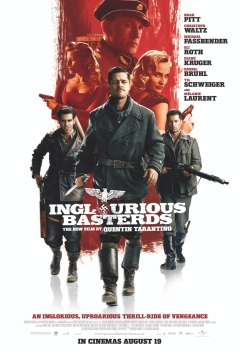 Inglorious Basterds is an insane but deeply satisfying World War II spaghetti western.
Inglorious Basterds is an insane but deeply satisfying World War II spaghetti western.